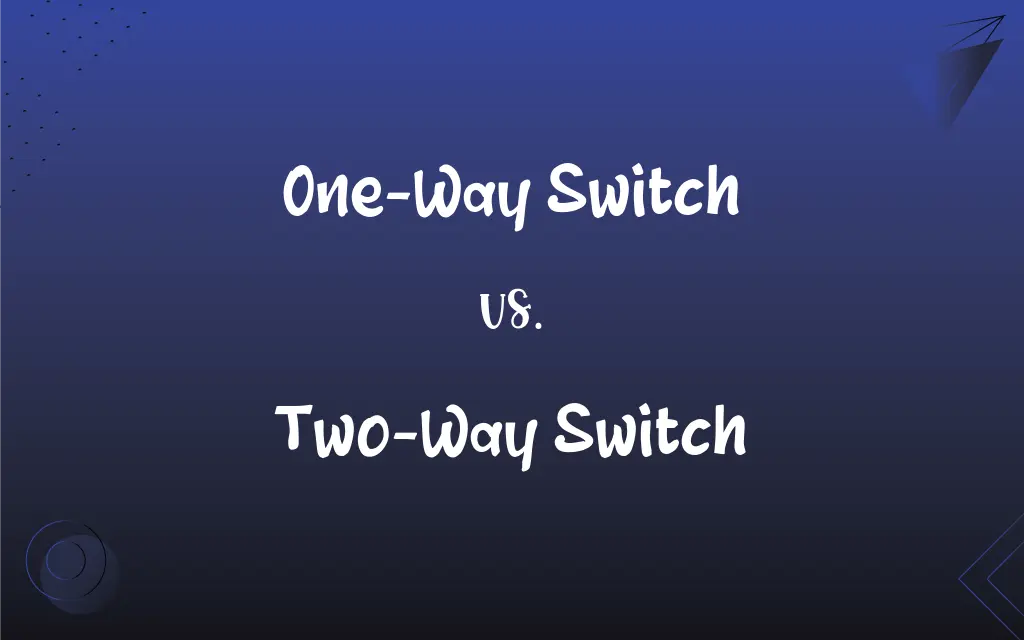One-Way Switch vs. Two-Way Switch: What's the Difference?
Edited by Aimie Carlson || By Janet White || Published on March 2, 2024
A one-way switch controls a light from one location, while a two-way switch allows control from two different locations.

Key Differences
A one-way switch is a simple electrical switch that allows you to control a light or another device from a single location. It has two positions: on and off, making it straightforward to operate for turning a device on or off from one place. A two-way switch, on the other hand, enables control of a single light or device from two different locations. This is particularly useful in large rooms or hallways where you might want to turn on or off a light from either end.
One-way switches are typically used in smaller rooms where single-point control is sufficient. They have a simple wiring configuration, making them easier and less expensive to install compared to their counterparts. Two-way switches require a more complex wiring setup because they need to connect with another two-way switch, allowing for the dual control points. This complexity can slightly increase the installation cost and effort.
The functionality of a one-way switch is basic, providing an uncomplicated user experience. Once flipped, it remains in its new state until manually changed again. Two-way switches, however, work in pairs to offer a flexible control scheme. Flipping one switch will change the current state of the light, regardless of which position the other switch is in, adding convenience but also requiring a basic understanding of their interlinked operation.
One-way switches are perfect for straightforward applications, two-way switches offer enhanced functionality. The choice between them depends on the specific needs of a room or space. Two-way switches are invaluable in multi-entry rooms, allowing for efficient and convenient light control, whereas one-way switches serve well in simpler, single-entry spaces.
One-way switches and two-way switches cater to different needs and preferences. The simplicity of a one-way switch is unmatched for ease of installation and use in appropriate settings. Meanwhile, two-way switches provide a higher level of convenience and flexibility for lighting control in more complex environments. Their use is dictated by the layout of the space and the desired level of control over lighting.
ADVERTISEMENT
Comparison Chart
Control Points
Single location
Two locations
Wiring Complexity
Simple
Complex
Installation Cost
Lower
Higher
Operational Complexity
Straightforward
Requires understanding of dual control mechanism
Ideal Usage Scenario
Smaller rooms or spaces with a single entry
Larger rooms or spaces with multiple entries
ADVERTISEMENT
One-Way Switch and Two-Way Switch Definitions
One-Way Switch
A simple on/off switch for basic electrical operations.
Use the one-way switch to turn off the fan when you leave.
Two-Way Switch
A double-pole, double-throw (DPDT) switch for enhanced control flexibility.
The two-way switch setup in the conference room facilitates easy lighting adjustments.
One-Way Switch
An electrical component for manual operation of a device from one place.
The garage light is operated by a one-way switch near the entrance.
Two-Way Switch
An electrical switch designed for convenience in multi-entry areas.
Installing a two-way switch for the basement lights was a smart decision.
One-Way Switch
A switch that controls an electrical circuit from a single point.
He installed a one-way switch for the closet light.
Two-Way Switch
A device for managing lighting or other electrical devices across two places.
The two-way switch allows you to control the living room lights from both entrances.
One-Way Switch
An electrical device for turning on or off a light from one location.
The one-way switch by the door controls the ceiling lamp.
Two-Way Switch
An electrical switch enabling on/off control from multiple points.
The two-way switch at the top and bottom of the stairs is very convenient.
One-Way Switch
A single-pole, single-throw (SPST) switch for straightforward control.
The one-way switch for the kitchen light is next to the refrigerator.
Two-Way Switch
A switch that allows control of an electrical circuit from two different locations.
They installed a two-way switch for the hallway lights.
FAQs
What is a two-way switch?
A two-way switch allows for the control of a device from two different locations.
Can I use a two-way switch in place of a one-way switch?
Yes, but it involves unnecessary complexity and cost for simple applications.
Are two-way switches more expensive than one-way switches?
Generally, yes, due to their increased functionality and wiring complexity.
Is it difficult to install a two-way switch?
It's more complex than installing a one-way switch due to the need for additional wiring.
What is a one-way switch?
A one-way switch is an electrical switch that controls a device from a single location.
Can two-way switches control more than one light?
Yes, they can control multiple lights if wired correctly.
Do one-way switches work with all types of lights?
Yes, one-way switches can control any standard electrical light or device.
Can I control a light from more than two locations?
Yes, but this requires using an intermediate or multi-way switch setup, not just two-way switches.
Are two-way switches used in commercial buildings?
Yes, they are commonly used in both residential and commercial settings for convenience and safety.
Do I need a special type of wire for two-way switches?
You may need three-core cable, unlike the two-core cable often used for one-way switches.
What safety precautions should I take when installing switches?
Always turn off the power at the breaker before working on electrical wiring.
What is the main advantage of a two-way switch?
The main advantage is the ability to control lights or devices from two different locations.
Can one-way switches be used outdoors?
Yes, if they are rated for outdoor use and properly weatherproofed.
Can I replace a one-way switch with a two-way switch for future expansion?
Yes, but ensure the wiring supports the functionality you plan to add.
Are there wireless two-way switches?
Yes, wireless switches can control lights from multiple locations without traditional wiring.
Can a two-way switch control multiple circuits?
Typically, a two-way switch controls one circuit, but with additional switches, you can design more complex control schemes.
Can I use a two-way switch with a dimmer?
Yes, there are two-way dimmer switches designed for this purpose.
How do I identify a two-way switch?
By its three terminals: two for the two-way function and one common terminal.
How do I troubleshoot a non-working two-way switch?
Check for loose connections, improper wiring, or a faulty switch.
Do smart switches come in one-way and two-way versions?
Yes, smart switches offer flexible control options, including one-way and two-way functionality.
About Author
Written by
Janet WhiteJanet White has been an esteemed writer and blogger for Difference Wiki. Holding a Master's degree in Science and Medical Journalism from the prestigious Boston University, she has consistently demonstrated her expertise and passion for her field. When she's not immersed in her work, Janet relishes her time exercising, delving into a good book, and cherishing moments with friends and family.
Edited by
Aimie CarlsonAimie Carlson, holding a master's degree in English literature, is a fervent English language enthusiast. She lends her writing talents to Difference Wiki, a prominent website that specializes in comparisons, offering readers insightful analyses that both captivate and inform.































































